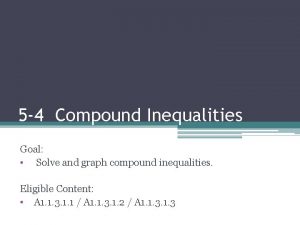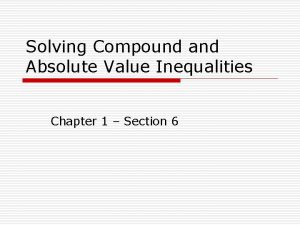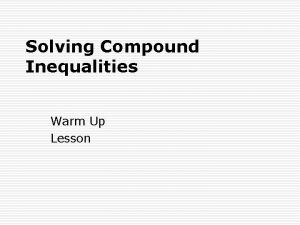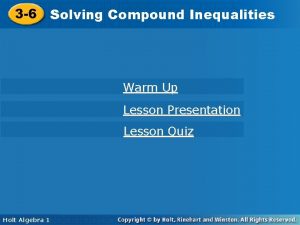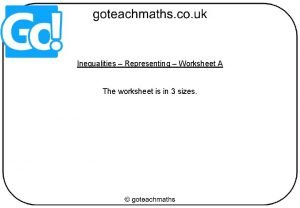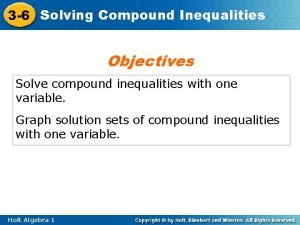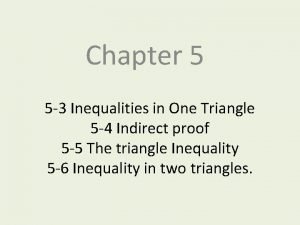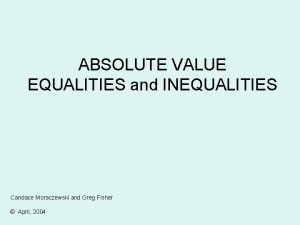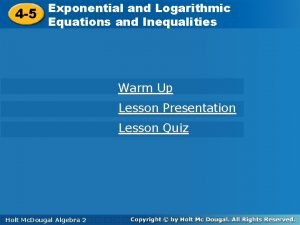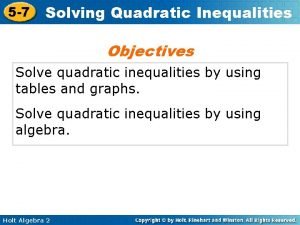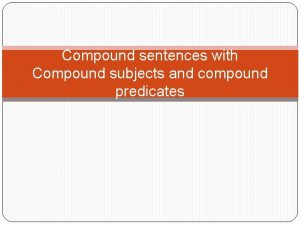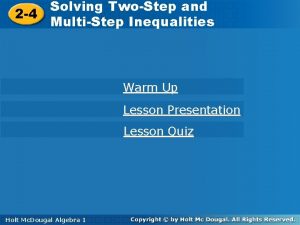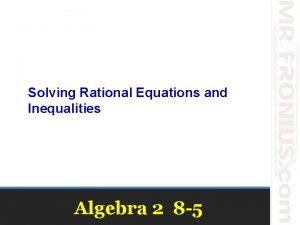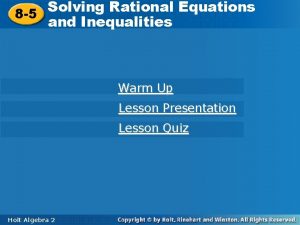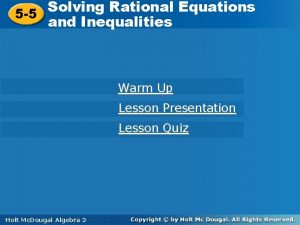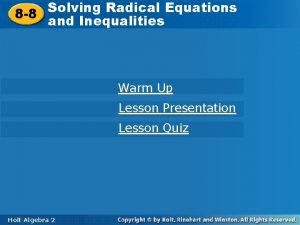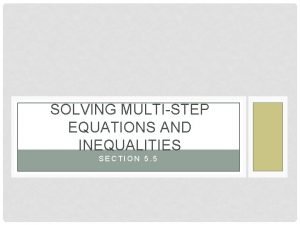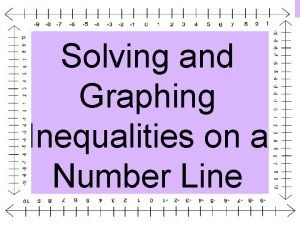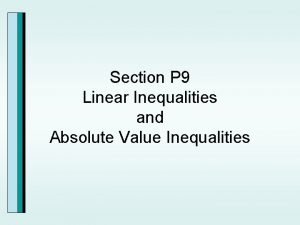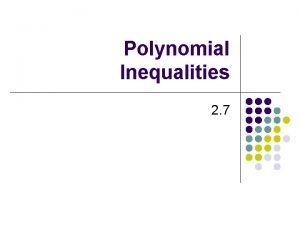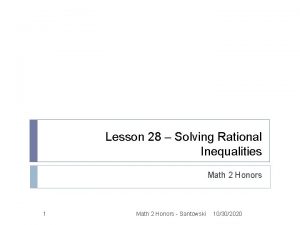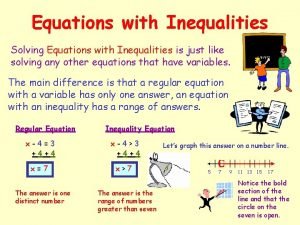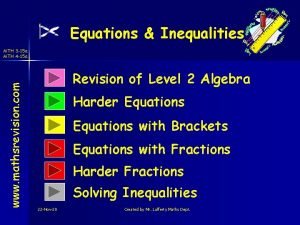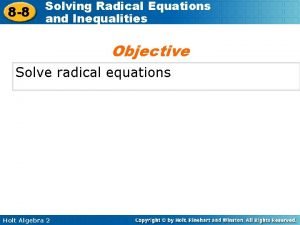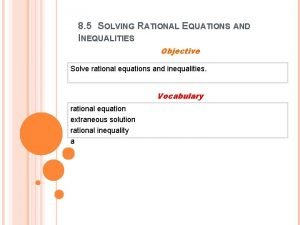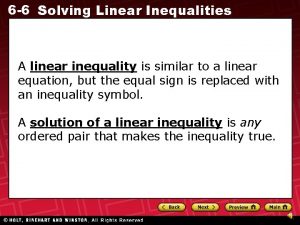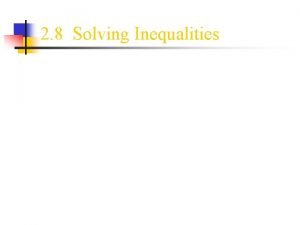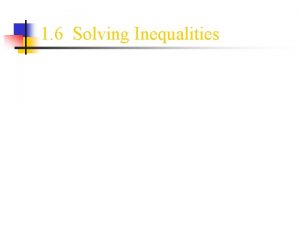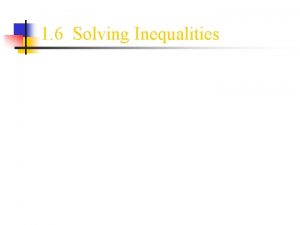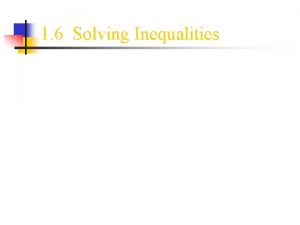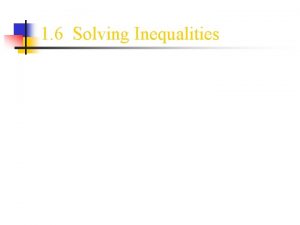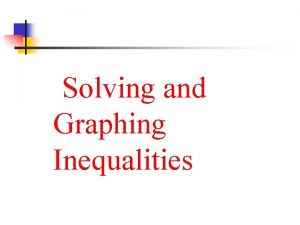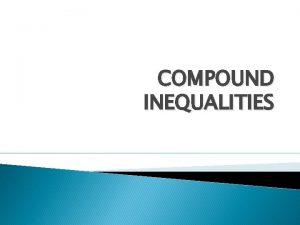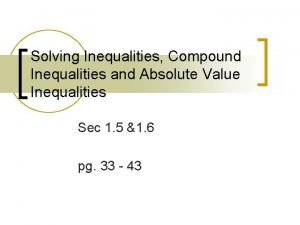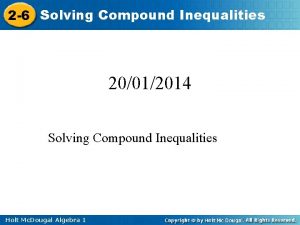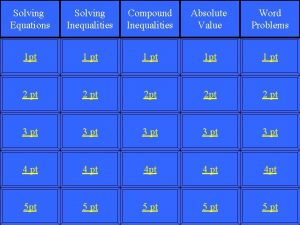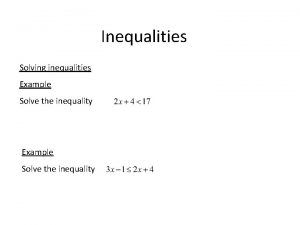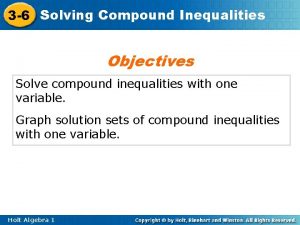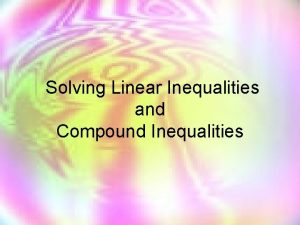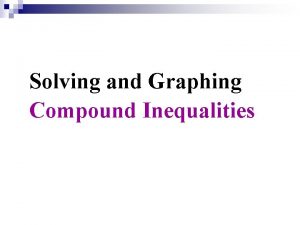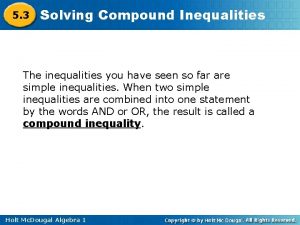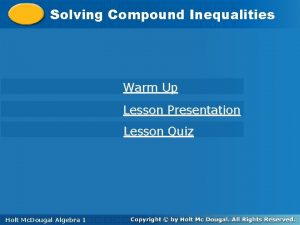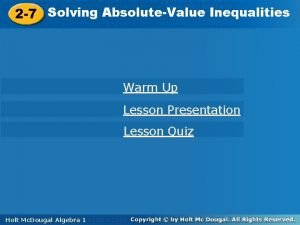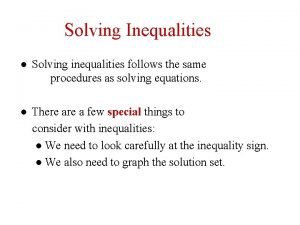6 4 Solving Compound Inequalities EXAMPLE 1 Write


































- Slides: 34

6. 4 Solving Compound Inequalities

EXAMPLE 1 Write and graph compound inequalities Translate the verbal phrase into an inequality. Then graph the inequality. a. All real numbers that are greater than – 2 and less than 3. Inequality: – 2 < x < 3 Graph: b. All real numbers that are less than 0 or greater than or equal to 2. Inequality: x < 0 or x ≥ 2 Graph:

GUIDED PRACTICE 1. for Example 1 All real numbers that are less than – 1 or greater than or equal to 4. Inequality: x < – 1 or x ≥ 4 Graph: – 2 2. – 1 0 1 2 3 4 5 All real numbers that are greater than or equal To – 3 & less than 5. Inequality: x ≥ – 3 or x < 5 = – 3 ≤ x < 5 Graph: – 4 – 3 – 2 – 1 0 1 2 3 4 5 6

EXAMPLE 2 Write and graph a real-world compound inequality CAMERA CARS A crane sits on top of a camera car and faces toward the front. The crane’s maximum height and minimum height above the ground are shown. Write and graph a compound inequality that describes the possible heights of the crane.

EXAMPLE 2 Write and graph a real-world compound inequality SOLUTION Let h represent the height (in feet) of the crane. All possible heights are greater than or equal to 4 feet and less than or equal to 18 feet. So, the inequality is 4 ≤ h ≤ 18.

EXAMPLE 3 Solve a compound inequality with and Solve 2 < x + 5 < 9. Graph your solution. SOLUTION Separate the compound inequality into two inequalities. Then solve each inequality separately. 2 < x + 5 and x+5<9 Write two inequalities. 2 – 5 < x + 5 – 5 and x + 5 – 5 < 9 – 5 Subtract 5 from each side. 23 < x and x<4 Simplify. The compound inequality can be written as – 3 < x < 4.

EXAMPLE 3 Solve a compound inequality with and ANSWER The solutions are all real numbers greater than 23 and less than 4.

GUIDED PRACTICE for Example 2 and 3 Investing 3. An investor buys shares of a stock and will sell them if the change c in value from the purchase price of a share is less than –$3. 00 or greater than $4. 50. Write and graph a compound inequality that describes the changes in value for which the shares will be sold. SOLUTION Let c represents the change in the value from the purchase price of share all possible changes is less than –$3. 00 or greater than $4. 50.

for Example 2 and 3 GUIDED PRACTICE So the inequality is c < – 3 or c > 4. 5. Graph: – 4 – 3 – 2 – 1 0 1 2 3 4 5 6

EXAMPLE 3 for Example 2 and 3 with and Solve a compound inequality GUIDED PRACTICE solve the inequality. Graph your solution. 4. – 7 < x – 5 < 4 SOLUTION Separate the compound inequality into two inequalities. Then solve each inequality separately. – 7 < x – 5 and x– 5<4 Write two inequalities. – 7 + 5 < x – 5 + 5 and x – 5 + 5 < 4 + 5 Add 5 to each side. – 2 < x and x<9 Simplify. The compound inequality can be written as – 2 < x < 9.

EXAMPLE 3 GUIDED PRACTICE for Example 2 and 3 ANSWER The solutions are all real numbers greater than – 2 & less than 9. Graph: – 3 – 2 – 1 0 1 2 3 4 5

GUIDED PRACTICE for Example 2 and 3 Solve the inequality. Graph your solution. 5. 10 ≤ 2 y + 4 ≤ 24 SOLUTION Separate the compound inequality into two inequalities. Then solve each inequality separately. 10 ≤ 2 y + 4 and 2 y + 4 ≤ 24 Write two inequalities. 10 – 4 ≤ 2 y + 4 – 4 and 2 y + 4 – 4 ≤ 24 – 4 subtract 4 from each side. 6 ≤ 2 y and 2 y ≤ 20 Simplify. 3 ≤ y and y ≤ 10 The compound inequality can be written as 3 ≤ y ≤ 10.

EXAMPLE 3 for Example 2 and 3 with and Solve a compound inequality GUIDED PRACTICE ANSWER The solutions are all real numbers greater than 3 & less than 10. Graph: -3 -2 -1 0 1 2 3 4 5 6 7 8 9 10 11 12

EXAMPLE 3 for Example 2 and 3 with and Solve a compound inequality GUIDED PRACTICE Solve the inequality. Graph your solution. 6. – 7< –z – 1 < 3 SOLUTION Separate the compound inequality into two inequalities. Then solve each inequality separately. – 7 < –z – 1 and –z – 1 < 3 Write two inequalities. – 7 + 1< –z – 1 + 1 and –z – 1+1 < 3 + 1 Add 1 to each side. 6< z and z > – 4 Simplify. The compound inequality can be written as – 4 < z < 6.

EXAMPLE 4 Solve a compound inequality with and Solve – 5 ≤ – x – 3 ≤ 2. Graph your solution. – 5≤–x– 3≤ 2 Write original inequality. – 5+3≤–x– 3+3≤ 2+3 Add 3 to each expression. – 2≤–x≤ 5 – 1(– 2) > – – 1(– x) > – – 1(5) 2> – – 5 –x > Simplify. Multiply each expression by – 1 and reverse both inequality symbols. Simplify.

EXAMPLE 4 Solve a compound inequality with and – 5≤x≤ 2 ANSWER The solutions are all real numbers greater than or equal to – 5 and less than or equal to 2. Rewrite in the form a ≤ x ≤ b.

EXAMPLE 5 Solve a compound inequality with or Solve 2 x + 3 < 9 or 3 x – 6 > 12. Graph your solution. SOLUTION Solve the two inequalities separately. 2 x + 3 < 9 or 3 x – 6 > 12 2 x + 3 – 3 < 9 – 3 or 3 x – 6 + 6 > 12 + 6 2 x < 6 or 3 x > 18 Write original inequality. Addition or Subtraction property of inequality Simplify.

EXAMPLE 5 Solve a compound inequality with or 2 x < 6 2 2 or 3 x 18 > 3 3 x<3 or x>6 Division property of inequality Simplify. ANSWER The solutions are all real numbers less than 3 or greater than 6.

GUIDED PRACTICE for Examples 4 and 5 Solve the inequality. Graph your solution. 7. – 14 < x – 8 < – 1 SOLUTION – 14 < x – 8 < – 1 Write original inequality. – 14 + 8 < x – 8 + 8 < – 1 + 8 Add 8 to each expression. – 6< x<7 Simplify.

GUIDED PRACTICE for Examples 4 and 5 ANSWER The solutions are all real numbers greater than or equal to – 6 and less than 7. – 7 – 6 – 5 – 4 – 3 – 2 – 1 0 1 2 3 4 5 6 7

GUIDED PRACTICE for Examples 4 and 5 8. – 1 ≤ – 5 t + 2 ≤ 4 SOLUTION – 1 ≤ – 5 t + 2 and – 5 t + 2 ≤ 4 Write two inequalities. – 1 – 2 ≤ – 5 t + 2 – 2 and – 5 t + 2 – 2 ≤ 4 – 2 Subtract 2 from each expression. – 3 ≤ – 5 t and – 5 t ≤ 2 – 2 ≤t≤ 3 5 5 Simplify. Rewrite in the form a ≤ x ≤ b.

GUIDED PRACTICE for Examples 4 and 5 ANSWER The solutions are all real numbers greater than – 2 5 3 and less than. 5 – 2 – 1 0 1 2 3 5 5 5

for Examples 4 and 5 GUIDED PRACTICE 9. 3 h + 1< – 5 or 2 h – 5 > 7 SOLUTION or 3 h + 1< – 5 2 h – 5 > 7 3 h + 1 – 1< – 5 – 1 or Write two inequalities. 2 h – 5 > 7 – 5 Addition & Subtraction property inequalities. 3 h < – 6 or h < – 2 or 2 h > 12 h>6 Simplify.

GUIDED PRACTICE for Examples 4 and 5 ANSWER The solutions are all real numbers less than – 2 and greater than 6. – 7 – 6 – 5 – 4 – 3 – 2 – 1 0 1 2 3 4 5 6 7

for Examples 4 and 5 GUIDED PRACTICE 10. 4 c + 1 ≤ – 3 or 5 c – 3 > 17 SOLUTION or 4 c + 1 ≤ – 3 5 c – 3 > 17 Write original inequality. 4 c + 1 – 1 ≤ – 3 – 1 or 5 c – 3 + 3> 17 +3 Addition & Subtraction property inequalities. 4 c ≤ – 4 or c ≤ – 1 or 5 c > 20 c>4 Simplify.

GUIDED PRACTICE for Examples 4 and 5 ANSWER The solutions are all real numbers less than – 1 and greater than 4. – 7 – 6 – 5 – 4 – 3 – 2 – 1 0 1 2 3 4 5 6 7

EXAMPLE 6 Solve a multi-step problem Astronomy The Mars Exploration Rovers Opportunity and Spirit are robots that were sent to Mars in 2003 in order to gather geological data about the planet. The temperature at the landing sites of the robots can range from 100°C to 0°C. • Write a compound inequality that describes the possible temperatures (in degrees Fahrenheit) at a landing site. • Solve the inequality. Then graph your solution. • Identify three possible temperatures (in degrees Fahrenheit) at a landing site.

EXAMPLE 6 Solve a multi-step problem SOLUTION Let F represent the temperature in degrees Fahrenheit, and let C represent the temperature in degrees Celsius. Use the formula C = 5 (F – 32). 9 STEP 1 Write a compound inequality. Because the temperature at a landing site ranges from – 100°C to 0°C, the lowest possible temperature is – 100°C, and the highest possible temperature is 0°C. – 100 < C < 0 Write inequality using C. – 100 < 5 (F – 32) < 0 9 Substitute 5 (F – 32) for C. 9

EXAMPLE 6 Solve a multi-step problem STEP 2 Solve the inequality. Then graph your solution. – 100 < 5 (F – 32) < 0 9 Write inequality from Step 1. – 180 < (F – 32 ) < 0 Multiply each expression by – 148 < F < 32 Add 32 to each expression. 5. 9

EXAMPLE 6 Solve a multi-step problem STEP 3 Identify three possible temperatures. The temperature at a landing site is greater than or equal to – 148°F and less than or equal to 32°F. Three possible temperatures are – 115°F, and 32°F.

GUIDED PRACTICE 11. . . for Example 6 Mars has a maximum temperature of 7°c at the equator and a minimum temperature of – 133°c at winter people. Write and solve a compound inequality that describes the possible temperatures (in degree Fahrenheit) on Mars. Graph your solution. Then identify three possible temperatures (in degrees Fahrenheit) on Mars. SOLUTION Let f represent the temperature in degrees Fahrenheit and let C represent temperature in degrees Celsius. Use the formula C = 5 ( f – 32). 9

EXAMPLE 6 for Example 6 Solve a multi-step problem GUIDED PRACTICE Write a compound inequality because the temperatures at a landing site ranges from – 133°c to 27°c, the lowest possible temperature is – 133°c and highest possible temperature is 27°c. – 133°c ≤ 7°c – 133°c ≤ 5 ( f – 32) ≤ 9 Write inequalities using c. 7°c substitute for 5 ( f – 32) c. 9

EXAMPLE 6 for Example 6 Solve a multi-step problem GUIDED PRACTICE Solve the inequality. – 133°c ≤ 5 ( f – 32) ≤ 9 7°c – 239. 4 ≤ f – 32 ≤ 48. 6 – 239. 4+32 ≤ f – 32 + 32 ≤ 48. 6 + 32 – 207. 4 ≤ f ≤ 80. 6 Write inequality. multiply each expression by 9. 5 Add 32 to each expression. Simplify.

EXAMPLE 6 for Example 6 Solve a multi-step problem GUIDED PRACTICE 80. 6 – 207. 4 Graph: -300 -200 -100 0 100 200 ANSWER Identify three possible temperature. The Temperature at landing site is greater than or equal to – 207. 40 f and less than or equal to 80. 60 f. Three possible temperatures are – 100°f, 25°f.
 Compound inequality worksheet
Compound inequality worksheet Compound absolute value inequalities
Compound absolute value inequalities 5-4 solving compound inequalities
5-4 solving compound inequalities Write compound inequalities from graphs
Write compound inequalities from graphs 1-6 solving compound and absolute value inequalities
1-6 solving compound and absolute value inequalities Lesson 3-3 compound inequalities
Lesson 3-3 compound inequalities 3-6 compound inequalities answer key
3-6 compound inequalities answer key Compound inequalities worksheet
Compound inequalities worksheet 3-6 compound inequalities
3-6 compound inequalities 5-3 inequalities in one triangle
5-3 inequalities in one triangle 1-6 solving compound and absolute value inequalities
1-6 solving compound and absolute value inequalities How to write compound inequalities
How to write compound inequalities Exponential and logarithmic equations and inequalities
Exponential and logarithmic equations and inequalities 3-7 practice quadratic inequalities
3-7 practice quadratic inequalities Simple predicate examples
Simple predicate examples Solving systems of linear inequalities by graphing
Solving systems of linear inequalities by graphing Solving 2 step inequalities
Solving 2 step inequalities How to solve rational equations and inequalities
How to solve rational equations and inequalities 8-5 solving rational equations and inequalities
8-5 solving rational equations and inequalities 5-5 solving rational equations and inequalities
5-5 solving rational equations and inequalities Radical inequality
Radical inequality Inequalities with radicals
Inequalities with radicals Solving multi step equations and inequalities
Solving multi step equations and inequalities Solving inequalities by multiplying or dividing
Solving inequalities by multiplying or dividing Solving and graphing inequalities on a number line
Solving and graphing inequalities on a number line Solving absolute value inequalities calculator
Solving absolute value inequalities calculator How to solve polynomial inequality
How to solve polynomial inequality Solving equations and inequalities jeopardy
Solving equations and inequalities jeopardy Rational inequality examples
Rational inequality examples Inequalities from word problems
Inequalities from word problems How to solve inequalities
How to solve inequalities Brackets equations and inequalities
Brackets equations and inequalities Solving radical equations and inequalities
Solving radical equations and inequalities How to solve rational equations and inequalities
How to solve rational equations and inequalities Inequality of two variables
Inequality of two variables
